Hybrid Work: The Disruption of 2021

With June 15th passing this week, marking California’s first opening since the pandemic hit, returning to the office and creating hybrid work environments is front of mind for many employers and employees. Microsoft Worklab published a recent report on hybrid work as the next big disruption – what are the big trends, how are they playing out in our region, and where do we go from here?
1. Flexible work is here to stay
Many workers got to experience remote work for the first time and don’t want to leave the positives of the experience behind. Nationwide, 70% want to retain a hybrid model although many are also clamoring for in-person time with their teams. In our region, the COVID-19 Resilience Poll tells us that 63% of workers worked full-time in office before the pandemic but 69% want a hybrid model now to avoid commutes and maintain more flexible hours.
2. Leaders need increased connection to workers
A recent study shows that business leaders are faring better than their employees throughout the pandemic with 61% saying that they are thriving while only 38% of those without decision-making authority say the same. Further, disparities in pandemic impacts are contributing to a divide – younger workers, workers of color, and women have struggled through the pandemic more intensely than others and are less likely to be in leadership roles at work.
3. High productivity is masking an exhausted workforce
Anecdotally, companies are reporting high productivity this year with commute, travel time and distractions of the office eliminated. Microsoft data shows that chats, emails, meetings, and time spent in documents have significantly increased between February 2020 and February 2021. It also shows that 54% of workers feel overworked and 39% feel exhausted. Digital overload and increased isolation are seriously taxing workers.
4. Gen Z is at risk and will need to be re-energized
Gen-Z, or those between 18-25 years old, are feeling these effects the strongest. 60% of Gen Z are merely surviving or flat-out struggling right now. This age demographic reports struggling to get new ideas on the table, get a word in during meetings, and feel excited or engaged about work. Because they are younger, often single, early in career, and less financially stable – isolation, network connections, and meaningful engagement has been much harder during the pandemic. The COVID-19 Poll found that in our region these factors and others contributed to higher rates of stress, anxiety, and depression for our younger respondents.
5. Shrinking networks are endangering innovation
The pandemic shrunk our worlds – both personally and professionally. Research shows that interactions with our close networks increased while our interactions with our more distant networks decreased. This reduces the inflow of new ideas, stifling innovation.
6. Authenticity will spur productivity and wellbeing
2020 was the year that home life was made visible at work – children, pets, and personal spaces came with many of us to our virtual meetings and as a result we had the opportunity to see each other as full humans in ways that never came through in routine office life. Additionally, our shared vulnerability of going through a tough time together bonded co-workers in new ways.
7. Talent is everywhere in a hybrid work world
The pandemic accelerated the notion that we can work from anywhere – and that is exactly what many workers want to do. A study from LinkedIn reports that remote job postings increased five-fold and 46% of workers say they want to move this year, anticipating continued remote work opportunities. Remote work can increase access to job opportunities for underrepresented groups – the same study found that women, Gen-Z, those without a graduate degree are more likely to apply for remote work and women, Black, and Latino workers are more likely than white men to prefer remote work. People are at inflection points in their careers with 41% noting that they’d like to leave their job within the year. In Sacramento County, 40% of jobs are remote eligible by function, as reported by the Bay Area Council Economic Institute. Additionally, the trend is that people in high cost areas are moving to lower cost areas – translating to an influx of Bay area residents to our region, a spike in real estate prices and growth in our professional workforce.
The trends are clear – we are in the midst of major disruption and transition to different ways of doing work. There are some clear recommendations for both employers and the region at large:
Empower workers to be able to work in office or remote environments: a mix of both will result in flexibility, productivity, and increased connection and collaboration. Just as employers pivoted to remote, now is the time to pivot again to safely open offices and create a new type of environment that embraces hybrid work where possible. Solutions should address technology tools, office design, home accomodation, and policy practices that maximize hybrid options.
Combat digital exhaustion starting from the top: Leaders need to understand the challenges of workers and actively promote a culture that encourages strong work/life boundaries and downtime. Organizations and companies need to strengthen diversity, equity, and inclusion practices and policies to address the intersectional burdens that people of color and other underrepresented groups face at work.
Rebuild our collaborative fabric: Isolation and smaller networks have marked 2020 and 2021 so far. Expanding networks, building collaborative opportunities and environments, and reacquainting with more distant networks (slowly for introverts!) will be a key activity of 2021.
Enhance employee experience to attract talent: While workers are reconsidering career, location, and the opportunity landscape, employers must cultivate a diverse, inclusive, and flexible culture to attract top talent.
By maximizing the positives of the remote work experiences that we have experienced while mitigating the isolation and digital overload of the past year, 2021 is an opportunity to build stronger, more resilient organizations and businesses to support a trhiving, healthy, and innovative workforce.
To keep up with Valley Vision’s work to advance livability in the Sacramento region, subscribe to our Vantage Point email newsletter!
Evan Schmidt is Valley Vision’s Chief Executive Officer.


